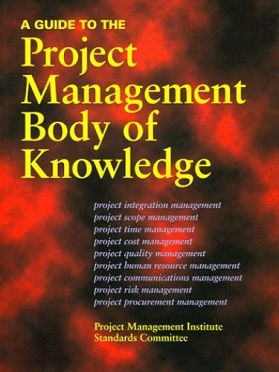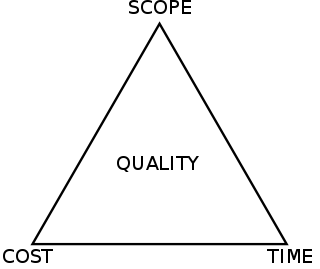Related Research Articles
Project management is the process of leading the work of a team to achieve all project goals within the given constraints. This information is usually described in project documentation, created at the beginning of the development process. The primary constraints are scope, time, and budget. The secondary challenge is to optimize the allocation of necessary inputs and apply them to meet pre-defined objectives.

A work-breakdown structure (WBS) in project management and systems engineering is a deliverable-oriented breakdown of a project into smaller components. A work breakdown structure is a key project deliverable that organizes the team's work into manageable sections. The Project Management Body of Knowledge defines the work-breakdown structure as a "hierarchical decomposition of the total scope of work to be carried out by the project team to accomplish the project objectives and create the required deliverables."
A project plan, according to the Project Management Body of Knowledge (PMBOK), is: "...a formal, approved document used to guide both project execution and project control. The primary uses of the project plan are to document planning assumptions and decisions, facilitate communication among project stakeholders, and document approved scope, cost, and schedule baselines. A project plan may be summarized or detailed."

The Project Management Body of Knowledge (PMBOK) is a set of standard terminology and guidelines for project management. The body of knowledge evolves over time and is presented in A Guide to the Project Management Body of Knowledge, a book whose seventh edition was released in 2021. This document results from work overseen by the Project Management Institute (PMI), which offers the CAPM and PMP certifications.
A software company is an organisation — owned either by state or private — established for profit whose primary products are various forms of software, software technology, distribution, and software product development. They make up the software industry.
The software release life cycle is the process of developing, testing, and distributing a software product. It typically consists of several stages, such as pre-alpha, alpha, beta, and release candidate, before the final version, or "gold," is released to the public.

In systems engineering and software engineering, requirements analysis focuses on the tasks that determine the needs or conditions to meet the new or altered product or project, taking account of the possibly conflicting requirements of the various stakeholders, analyzing, documenting, validating and managing software or system requirements.
In software development, agile practices include requirements discovery and solutions improvement through the collaborative effort of self-organizing and cross-functional teams with their customer(s)/end user(s), adaptive planning, evolutionary development, early delivery, continual improvement, and flexible responses to changes in requirements, capacity, and understanding of the problems to be solved. Popularized in the 2001 Manifesto for Agile Software Development, these values and principles were derived from and underpin a broad range of software development frameworks, including Scrum and Kanban.
Enterprise Project Management, in broad terms, is the field of organizational development that supports organizations in managing integrally and adapting themselves to the changes of a transformation. Enterprise Project Management is a way of thinking, communicating and working, supported by an information system, that organizes enterprise's resources in a direct relationship to the leadership's vision and the mission, strategy, goals and objectives that move the organization forward. Simply put, EPM provides a 360 degree view of the organization's collective efforts.
In agile principles, timeboxing allocates a maximum unit of time to an activity, called a timebox, within which planned activity takes place. It is used by agile principles-based project management approaches and for personal time management.
Project Management Professional (PMP) is an internationally recognized professional designation offered by the Project Management Institute (PMI). As of 31 July 2020, there are 1,036,368 active PMP-certified individuals and 314 chartered chapters across 214 countries and territories worldwide.
In software engineering, behavior-driven development (BDD) is an agile software development process that encourages collaboration among developers, quality assurance experts, and customer representatives in a software project. It encourages teams to use conversation and concrete examples to formalize a shared understanding of how the application should behave. It emerged from test-driven development (TDD). Behavior-driven development combines the general techniques and principles of TDD with ideas from domain-driven design and object-oriented analysis and design to provide software development and management teams with shared tools and a shared process to collaborate on software development.

Scrum is a framework for product management commonly used in software development, although it has been used in other fields including research, sales, marketing and advanced technologies. It is designed for teams of ten or fewer members who break their work into goals that can be completed within time-boxed iterations, called sprints. Each sprint is no longer than one month and most commonly lasts two weeks. The scrum team assesses progress in time-boxed daily meetings of up to 15 minutes, called daily scrums. At the end of the sprint, the team holds two further meetings: one sprint review intended to demonstrate the work done for stakeholders and solicit feedback, and one sprint retrospective intended to enable the team to reflect and improve.
Coding best practices or programming best practices are a set of informal rules that many software developers in computer programming follow to improve software quality. Many computer programs remain in use for long periods of time, so any rules need to facilitate both initial development and subsequent maintenance and enhancement of source code by people other than the original authors.
Terms of reference (TOR) define the purpose and structures of a project, committee, meeting, negotiation, or any similar collection of people who have agreed to work together to accomplish a shared goal.
Software quality management (SQM) is a management process that aims to develop and manage the quality of software in such a way so as to best ensure that the product meets the quality standards expected by the customer while also meeting any necessary regulatory and developer requirements, if any. Software quality managers require software to be tested before it is released to the market, and they do this using a cyclical process-based quality assessment in order to reveal and fix bugs before release. Their job is not only to ensure their software is in good shape for the consumer but also to encourage a culture of quality throughout the enterprise.
A glossary of terms relating to project management and consulting.

The project management triangle is a model of the constraints of project management. While its origins are unclear, it has been used since at least the 1950s. It contends that:
- The quality of work is constrained by the project's budget, deadlines and scope (features).
- The project manager can trade between constraints.
- Changes in one constraint necessitate changes in others to compensate or quality will suffer.
Lean project management is the application of lean concepts such as lean construction, lean manufacturing and lean thinking to project management.
The following outline is provided as an overview of and topical guide to project management:
References
- ↑ McConnell, Steve (1996-07-02). Rapid Development . Microsoft Press. ISBN 978-1-55615-900-8.
- ↑ McConnell, Steve. "Classic Mistakes Enumerated". stevemcconnell.com. Retrieved 2010-05-03.
- ↑ Atwood, Jeff (2004-12-07). "Gold Plating". CodingHorror.com.
- ↑ Atwood, Jeff (2008-07-15). "The Ultimate Software Gold Plating". CodingHorror.com.
- ↑ Fletcher, John. "Gold Plating". Archived from the original on 2011-07-18. Retrieved 2010-05-03.
- ↑ Burke, Simon, PMP (16 August 2022). "Gold Plating in Project Management". All Things Project Management. Retrieved 2022-10-14.